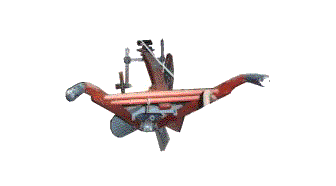Ploughing
Here's a working view of a plough from the "business end". This is one of the few wooden ploughs in the collection; most of them are steel.

John Gate, aged 84, originally from Wigton and after that a farmer at Mosedale, Orton and Tebay, recalls: "I bought a plough, twelfth of January 1934. How much? Nine guineas."
A farm man earned £1-10s-8d for a 50 hour week at that time, so the plough cost six weeks’ wages.
"There was an old man at Aikton, when I was just a boy, and he had always been used to ploughing with t'old swing plough. I bought an old un to ga round dyke backs with, but I could never use't, just howk among dyke backs with it. He used to say, any fathead could plough - but it took a good man to harrow."
A ploughman and his horses were expected to plough an acre a day. They would walk 11 miles between dawn and dusk. To see a champion ploughman teaching a novice, see the book of BBC 2's TV programme from January 2009, The Victorian Farm.
Ploughs in 1794
Pringle reported to the Board of Agriculture in 1794 that the ploughs of Westmorland were "light ... suited to the soil ... Some of them have a wheel at the extremity of the beam... They are drawn most commonly by two but sometimes by three horses. The turnwrist plough is about to be introduced into the county and will be of great service in ploughing the sides of the hills."